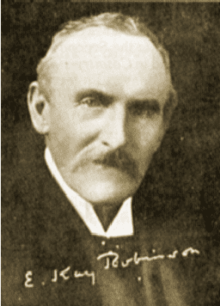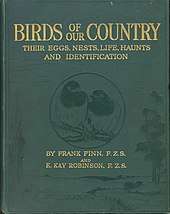E. Kay Robinson
Edward Kay Robinson FZS (12 December 1855 – 20 January 1928) was a British journalist and popularizer of natural history studies. He founded the British Empire Naturalists' Association in 1905. As an editor at Lahore of the Civil and Military Gazette he encouraged Rudyard Kipling in his early years.[1]
| E. Kay Robinson | |
|---|---|
 | |
| Born | 12 December 1855 Nainital |
| Died | 20 January 1928 Hampton Wick |
| Occupation | Journalist, newspaper editor, radio personality |
Early life
Robinson was born in Naini Tal to Julian Robinson, an East India Company chaplain and Harriett Woodcock, daughter of Thomas Sharpe, vicar of Doncaster and canon of York. Julian Robinson later worked with the Pioneer newspaper. Before Robinson turned nine, the family returned to England and settled at Cheltenham where he went to school at the Junior Proprietary School and College. Here he picked up an interest in natural history with an interest in the butterflies and moths. When Charles Darwin visited the school, Robinson was selected to show him around.[2] Robinson had two brothers and three sisters. The eldest brother Phil (1847–1902) helped his father in the newspaper and pioneered an Anglo-Indian style of humorous writing. The other brother Harry Perry also wrote some books. Robinson worked briefly as a schoolmaster before taking up journalism at the age of 19. He worked for a while at the Globe before going to Lahore in 1885, as editor of the Civil and Military Gazette where he was assisted by Rudyard Kipling. Kipling dedicated his "Life's Handicap" "To E.K.R. from R.K., 1887-89, CMG." A By The Way column was one of the innovations of Robinson at The Globe.[3] Robinson and Kipling wrote ballads signed respectively by "K.R." and "R.K."[4][5] He returned to England in 1895 and joined the Globe again. He started some newsletters from 1896 including "Science Gossip" and "Country Queries and Notes" and then merged them into the penny weekly Country-Side which was made as the official newsletter of the British Empire Naturalists' Association that he founded in 1905. He also published a monthly leaflet "The Meaning of Life", for those who try "to look through Nature up to Nature's God."[6] He initially lived in London but moved later to Northgate Hall, Norfolk from where he also wrote several books including To-day with Nature, My Nature Note book and The Country Day by Day. A newspaper in 1907 reported his breakdown from overwork leading to him taking a break in the Canary Islands.[7]
Natural history

Robinson gave talks especially in schools on natural history and was among the first to broadcast natural history talks on radio. In 1924, the BBC put up microphones in the Surrey woods to broadcast the song of nightingales along with a talk by Robinson.[8] His style of natural history writing was aimed to highlight the wonder of nature and not meant to be scientific. He aired ideas that were sometimes contrary to established theory proposing for instance that colourful flowers evolved to deter cattle and other grazers rather than to attract insects.[9] He was against animal cruelty and the idea of collection and museums for the study of natural history. He instead promoted photography.[10] He died at Hampton Wick in January 1928[11] and the funeral was held at Golders Green.[12]
Along with Frank Finn, he published a two volume book Birds of our Country in 1912.
He was a Fellow of the Zoological Society of London (FZS).
Personal life
He married Florence Gordon in 1887 and had three sons, one of whom was killed in the First World War. He died at his home in Hampton Wick after a long illness, aged 72.[1]
References
- "Mr. E. Kay Robinson – "The Religion of Nature"". The Times. The Times Digital Archive. 23 January 1928. p. 17.
- Tabor, Roger (1986). "The national body for naturalists— the British Naturalists' Association". Journal of Biological Education. 20 (1): 20–24. doi:10.1080/00219266.1986.9654770.
- Devoted to the early works of P. G. Wodehouse
- Robinson, Edward Kay (1896) "Kipling in India," McClure's Magazine, 2:106
- Kipling, Rudyard (1996). Writings on Writing. Cambridge University Press.
- "[Advertisement] "Country-side Leaflet"". Middlesex Chronicle. 15 December 1917. p. 4 – via British Newspaper Archive.
- "Mr. E. Kay Robinson. A popular editor". Gloucester Journal. 18 May 1907. p. 4 – via British Newspaper Archive.
- "To-day's novel wireless experiment". Western Morning News. 19 May 1924. p. 3 – via British Newspaper Archive.
- Dewar, Douglas; Finn, Frank. The making of species. London: John Lane. p. 261.
- "The "New Collecting."". Manchester Courier and Lancashire General Adviser. 5 February 1909. p. 14 – via British Newspaper Archive.
- "In Yoke with a Genius". Exeter and Plymouth Gazette. 25 January 1928. p. 8 – via British Newspaper Archive.
- "Personal and general". Bedfordshire Times and Independent. 3 February 1928. p. 7 – via British Newspaper Archive.
External links
| Wikisource has original works written by or about: E. Kay Robinson |
- Robinson, Phil, E. Kay Robinson, H. Perry Robinson (1902) Tales by three brothers. Isbister and Company, London.
- Robinson, E. Kay (1903) My Nature Notebook. Isbister & Company, London.
- Robinson, E. Kay (1905) The country day by day. William Heinemann, London.
- Robinson, E. Kay (1907) The Religion of Nature. McClure, Phillips & Co., New York.
- The County-Side (1906)
- The County-Side (1907)